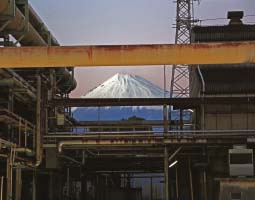Home > Highlighting JAPAN > Highlighting Japan August 2018 > How to Enjoy Summer in Japan
Highlighting JAPAN


The Otherworldly Magic of Factories After Dark
The ways to enjoy summer nights in Japan are constantly increasing, but you might be surprised to discover one of the most popular—taking in the fascinating views of vast factories lit up after dark.
When most people think of ways to enjoy summer nights in Japan, they probably imagine going to festivals and watching massive displays of fireworks. Lately, however, a wider assortment of night tours and events has emerged. The National Museum of Western Art, as well as other national museums and galleries in Tokyo, Kyoto and Osaka, have extended their hours. There are also night safaris to see nocturnal animals at zoos, and shrines and temples are being illuminated after the sun goes down.
Factory nightscapes across the country are also catching the attention of many. Illuminating massive factories after dark creates captivating scenes that seem straight out of a science fiction movie.
Professor Masaaki Okada at the Kindai University Faculty of Science and Engineering Department of Civil and Environmental Engineering studies technoscapes, meaning landscapes created by manmade structures. “Japan is an industrial nation, and has factories all over the country where you can enjoy these beautiful views,” he says. “Brightly lit chemical plants are particularly striking, thanks to the many pipes which cover the outside of the buildings. I believe it’s a rare opportunity to see this kind of otherworldly scene brightening the dark night, especially from up close.”
Factories were not purposely lit to create nice scenery, he acknowledges. But lately people have begun to notice their picturesque aspects and found different reasons to value them, which also softens the negative image of industrial plants as a source of pollution.
“From that process, I believe that this appreciation of factory nightscapes is a kind of subculture formed by the public,” he notes.
In fact, around the 1980s several photographers realized the beauty of factories after nightfall and began photographing them. According to Professor Okada, the real boom began in the early 2000s and began to pick up speed with the spread of social media and digital cameras. After that, the movement to visit industrial plants at night became a popular form of sightseeing, complete with bus tours and cruising tours. Starting in 2011, local governments with industrial zones, tourism associations and chambers of commerce began to share information annually at the All-Japan Factory Night View Summit, working together to discuss issues and make plans.
Asked which nighttime factory views he especially recommends and their highlights, Professor Okada had several suggestions. “All have their own unique charms, but if I were to pick, I highly recommend the Hachinohe industrial area in Aomori Prefecture, which is well known for illuminating steam and its colorful art events. Another is the Keihin industrial area in Kawasaki, Kanagawa Prefecture—one of the largest in Japan—and the wonderful nightscape visible from the JR Tsurumi Line, which runs by the factories. Shizuoka Prefecture’s paper industry area in Fuji City is also famous for factory nightscapes with Mount Fuji in the background, and the Gakunan Electric Train that weaves through the factory area.
“From the observatory deck of the Yokkaichi Port Building, you can get a 360-degree view of the Yokkaichi industrial complex in Mie Prefecture,” he continues. “And you can see the glittering lights from the Yamaguchi Shunan industrial complex reflecting against the sea from the windows of the Sanyo bullet train. The Kitakyushu industrial area in Fukuoka has a 205-meter-high chimney lit up with LEDs in five different colors. You can see all of these for free, of course, but it’s far more enjoyable if you take part in a tour and learn about the factories themselves.”
There are also courses to explore parts of the factories normally not open to the public. New tours are being put together, allowing more people to indulge in the nighttime realm of factories that show a magically different face from those seen during the day.
© 2009 Cabinet Office, Government of Japan








